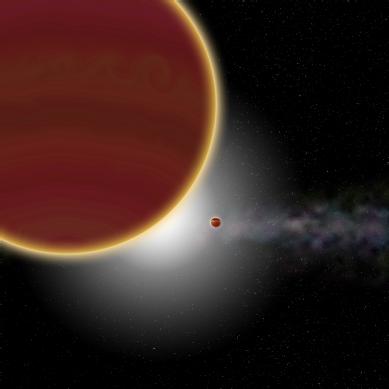New planet nine times the mass of Jupiter found in nearby star system
- New discovery marks the first planetary system where one planet has been detected directly and a second planet through the indirect methods
- β Pictoris c is nine times the mass of Jupiter – and over 2800 times as massive as Earth
- International team of astronomers includes University of Warwick
- “It provides us with an excellent candidate for follow-up observations which can give us insight into how planets form.”
 An international team including a University of Warwick astronomer has discovered a new planet around a nearby star.
An international team including a University of Warwick astronomer has discovered a new planet around a nearby star.
A team of astronomers led by Anne-Marie Lagrange, a CNRS researcher at the Institut de Planétologie et d’Astrophysique de Grenoble (CNRS/Université Grenoble Alpes)1 and including Dr Paul A. Wilson from the University of Warwick, has discovered a second giant planet in orbit around β Pictoris, a star that is relatively young (23 million years old) and close (63.4 light years), and surrounded by a disk of dust.
The β Pictoris system has fascinated astronomers for the last thirty years since it enables them to observe a planetary system in the process of forming around its star. Comets have been discovered in the system, as well as a gas giant, β Pictoris b, detected by direct imaging and described in 2009 by Lagrange’s team.
This time, the team had to analyse more than 10 years of high-resolution data, obtained with the HARPS instrument at ESO's La Silla Observatory in Chile, in order to indirectly detect the presence of β Pictoris c.² This second giant planet, which has a mass nine times that of Jupiter, completes its orbit in roughly 1,200 days, and is relatively close to its star (approximately the distance between the Sun and the asteroid belt, whereas β Pictoris b is 3.3 times more distant). The researchers hope to find out more about the planet from data from the GAIA spacecraft and from the future Extremely Large Telescope now under construction in Chile.
Dr Paul A. Wilson from the University of Warwick’s Department of Physics and co-author on the paper said: "The newly discovered planet Beta Pictoris c is a part of a planetary system where planets have for the first time been discovered both through direct imaging and via indirect techniques.
“The planet marks an important discovery as it provides us with an excellent candidate for follow-up observations which can give us insight into how planets form, in particular, the way the material is accreted onto the planet embryo."
Notes
1. The team includes researchers from other French laboratories – Lagrange laboratory (CNRS/Observatoire de la Côte d’Azur/Université Côte d’Azur), Laboratoire d'études spatiales et d'instrumentation en astrophysique (CNRS/Observatoire de Paris – PSL/Sorbonne Université/Université de Paris), Institut d’astrophysique de Paris (CNRS/Sorbonne Université) – as well as researchers from the Max Planck Institute for Astronomy (Germany), the South African Astronomical Observatory, the University of Warwick (UK), Leiden Observatory (the Netherlands), European Southern Observatory, Universidad de Chile and Universidad de Valparaiso (Chile).
2. The method used was the radial velocity method: planets and stars orbit around a common centre of gravity which is usually located within the star. Thus, in the presence of a planet, the star describes orbits that are very small but nonetheless detectable by the radial velocity method, which is based on the Doppler effect (its light spectrum shifts alternately towards blue and red). Since β Pictoris is a relatively massive star (almost twice the mass of the Sun) that undergoes considerable pulsations (its size varies periodically), the signal obtained is extremely complicated, and it was first necessary to subtract the effect of the pulsations. In fact, this is the first time that a planet has been detected around such a star using this method.
Ends
Notes to editors:
Artist’s impression can be downloaded at: https://warwick.ac.uk/services/communications/medialibrary/images/august2019/bpic_system_hires.jpg
Caption: Artist’s impression of the β Pictoris system. At least two giant planets, aged 20 million years at most, orbit around the star (which is hidden): β Pictoris c, the nearest one, which has just been discovered, and β Pictoris b, which is more distant. The disk of dust and gas can be seen in the background. © P Rubini / AM Lagrange
Bibliography
Evidence for an additional planet in the β Pictoris system, Anne-Marie Lagrange, Nadège Meunier, Pascal Rubini, Miriam Keppler, Franck Galland, Eric Chapellier, Eric Michel, Luis Balona, Hervé Beust, Tristan Guillot, Antoine Grandjean, Simon Borgniet, Djamel Mekarnia, Paul Anthony Wilson, Flavien Kiefer, Mickael Bonnefoy, Jorge Lillo-Box, Blake Pantoja, Matias Jones Daniela Paz Iglesias, Laetitia Rodet, Matias Diaz, Abner Zapata, Lyu Abe, François-Xavier Schmider. Nature Astronomy, 19 Augsut 2019. DOI: 10.1038/s41550-019-0857-1
Press contacts
Véronique Etienne
CNRS press officer
+33 1 44 96 51 37
20 August 2019
For interviews with Dr Paul Wilson contact:
Peter Thorley
Media Relations Manager (Warwick Medical School and Department of Physics)
Email: peter.thorley@warwick.ac.uk
Tel: +44 (0)24 761 50868
Mob: +44 (0) 7824 540863
